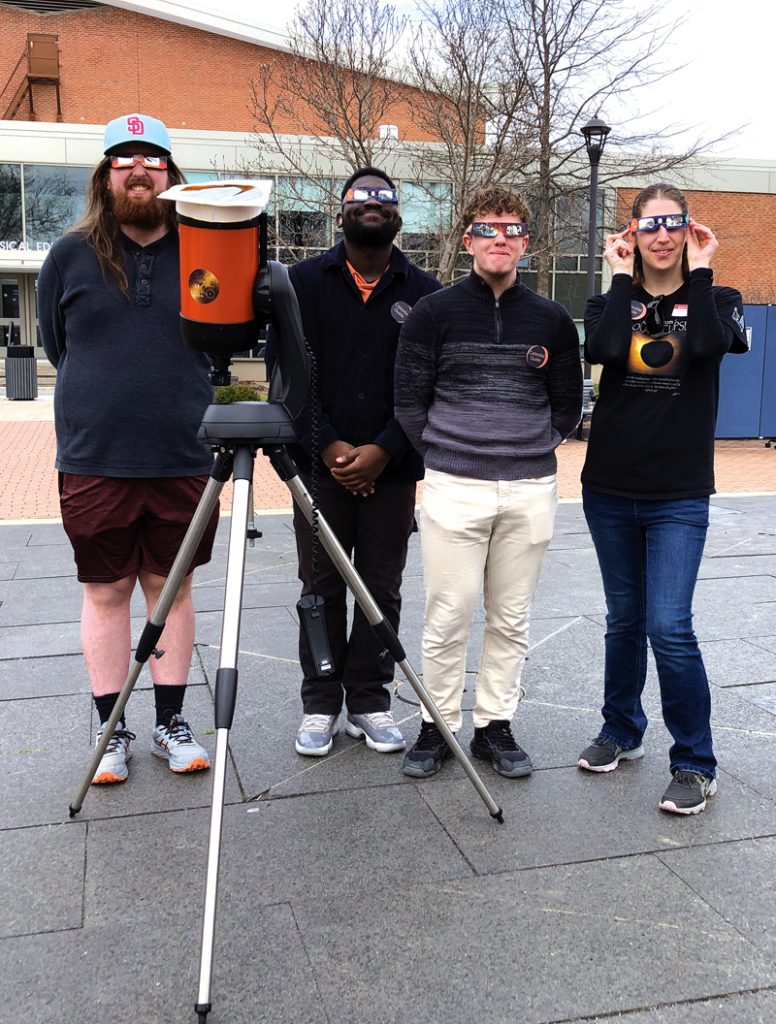Eclipse Viewing Party at SUNY Oneonta Attracts Thousands

By MONICA CALZOLARI
ONEONTA
Seeing the total eclipse is a very exciting, once-in-a-lifetime opportunity for millions of people across the United States,” said Skyler Reed, a junior at SUNY Oneonta majoring in physics with a focus on astronomy.
Reed, who grew up in the Adirondacks, described himself as a science nerd. He used to watch science documentaries on TV, including Carl Sagan’s “Cosmos.” He chose SUNY Oneonta because, he said, “It has one of the best physics programs in all of SUNY.”
Dr. Valerie Rapson, assistant professor of physics and astronomy, said, “We have the largest optical telescope in New York State. We also have three research-grade telescopes at College Camp where our students can conduct research over the summer.”
College Camp is a cooperative venture of the Student Association, SUNY Oneonta and Oneonta Auxiliary Services. It sits on 276 acres of former farm and woodland, adjacent to campus, on Hoffman Road.
There are six professors of physics at SUNY Oneonta. Joshua Nollenberg, associate professor who also teaches astronomy, took some of his students to see the total eclipse in the Adirondacks near Lake Placid.
“About 40 students major in physics,” according to Dr. Rapson.
Several of those students volunteered to staff the eclipse-related event on Monday, April 8 from noon to 5 p.m., which SUNY Oneonta spent months organizing.
Dr. Rapson said, “Our students here are phenomenal. They are passionate and smart.”
She has been at SUNY Oneonta for four years and has a research interest in star and planet formation.
According to the college website, Dr. Rapson “also conducts exoplanet research with students utilizing telescopes at the College Camp Observatory, and designs and presents planetarium shows.”
The A.J. Read Science Discovery Center on campus in the Physical Sciences building had a variety of engaging, hands-on STEM exhibits and art projects on Monday related to the eclipse.
In addition to faculty, staff, and students, retirees and children also attended the SUNY Oneonta solar eclipse viewing party.
Dr. William Walker, an assistant professor of museum studies in Cooperstown, brought his young son to play with robots inside the Discovery Center on campus and to view the eclipse outside. Oneonta’s Central School District had the day off from school.
SUNY Oneonta was the last place left in Oneonta with free protective glasses to watch the eclipse. They ran out at about 2:30 p.m. The Huntington Library ran out of its initial allotment of 300 glasses by 10:40 a.m. Monday morning.
The SUNY Oneonta event attracted a wide variety of participants. Some included the following:
Ryheime Grant, a physics major with a minor in astronomy, wants to be a mechanical engineer. He said, “I am fascinated by building things and how things work.”
Brendan Barry is a dual major in adolescent education majoring in social studies and history. Originally from Floral Park, on Long Island, Barry was on the board of The Nebula Society, a student organization that uses the SUNY Oneonta planetarium to learn about and spread knowledge of astronomy and related topics.
Samuel Sylvia, a double major in physics and math, transferred to SUNY Oneonta this year because of an interest in meteorology. He is interested in how particles in the atmosphere move. He explained, “Because the atmosphere is turbulent and fluid, the movement is hard to predict mathematically.” Sylvia is considering becoming a test engineer, a robotics engineer or a plasma physicist.
Cass Szkodzinsky, a SUNY Oneonta physics major who graduated in 2021, now works in the Student Academic Center with STEM students. Szkodzinsky, who is saving for graduate school, said, “I love helping a lot of students at all levels of math and calculus and getting the light bulb to go off for students.”
Joanne Tobey, director of gift planning, SUNY Oneonta, Division of University Advancement, was pleased that “this event brought so many people together.” She said, “We felt the impact of the solar eclipse on the environment. The campus night lights came on and it got chillier.”

